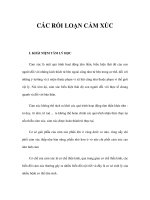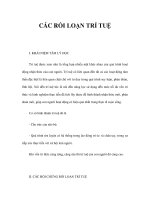Áp lực đẩy: Khái niệm, Sinh lý học, Giá trị và giới hạn, Điều chỉnh trong bệnh nhân ARDS
Bạn đang xem bản rút gọn của tài liệu. Xem và tải ngay bản đầy đủ của tài liệu tại đây (2 MB, 33 trang )
<span class='text_page_counter'>(1)</span><div class='page_container' data-page=1>
Driving Pressure
Definition, Physiology, Value and Limitations
JOSHUA SOLOMON, MD
ASSOCIATE PROFESSOR OF MEDICINE
NATIONAL JEWISH HEALTH
</div>
<span class='text_page_counter'>(2)</span><div class='page_container' data-page=2>
Outline
• Background
• What is Driving Pressure?
• Value of Driving Pressure
• How do we use it in clinical practice
</div>
<span class='text_page_counter'>(3)</span><div class='page_container' data-page=3>
Normal
</div>
<span class='text_page_counter'>(4)</span><div class='page_container' data-page=4>
ARDS
“Functional
Lung”
Lungs aren’t STIFF – they are SMALL!
Consolidation
=
</div>
<span class='text_page_counter'>(5)</span><div class='page_container' data-page=5></div>
<span class='text_page_counter'>(6)</span><div class='page_container' data-page=6>
Tonetti et al. Annals of Trans Med 2017; 5: 286
</div>
<span class='text_page_counter'>(7)</span><div class='page_container' data-page=7></div>
<span class='text_page_counter'>(8)</span><div class='page_container' data-page=8></div>
<span class='text_page_counter'>(9)</span><div class='page_container' data-page=9>
Pressure
Resp
Rate
Volume
</div>
<span class='text_page_counter'>(10)</span><div class='page_container' data-page=10>
POWER
</div>
<span class='text_page_counter'>(11)</span><div class='page_container' data-page=11></div>
<span class='text_page_counter'>(12)</span><div class='page_container' data-page=12>
Lung Compliance
• Is change in volume for
any given change in
pressure
• Formula - △V/△P
• Hysteresis – inspiration
and exhalation are
different due to the extra
work to recruit and
</div>
<span class='text_page_counter'>(13)</span><div class='page_container' data-page=13></div>
<span class='text_page_counter'>(14)</span><div class='page_container' data-page=14>
ARDS Net Trial
◦ Low tidal volume
◦ <6 ml/kg vs. 12ml/kg
◦ Low plateau pressure
◦ <30 cm H<sub>2</sub>0
◦ Reduced mortality by 9% (39%
to 31%)
◦ Survival with ARDS 69%
</div>
<span class='text_page_counter'>(15)</span><div class='page_container' data-page=15></div>
<span class='text_page_counter'>(16)</span><div class='page_container' data-page=16>
Where is the most benefit?
• Low VT
• Low plateau pressures
</div>
<span class='text_page_counter'>(17)</span><div class='page_container' data-page=17>
Driving Pressure
• Driving pressure normalizes the tidal volume to
the compliance of the respiratory system
△
P = V
<sub>t</sub>/ C
<sub>RS</sub></div>
<span class='text_page_counter'>(18)</span><div class='page_container' data-page=18>
Driving Pressure
•
DP normalizes the tidal volume to the
compliance of the respiratory system
△
P = V
<sub>t</sub>/ C
<sub>RS</sub></div>
<span class='text_page_counter'>(19)</span><div class='page_container' data-page=19>
www.pulmccm.org
• PEEP and VT set by
clinician
• Plateau are dependent on
settings
• Crs is derived and forms
slope of △V/△P
• The Crs changes
• Curve A – over distention
• Curve B – recruitment
maneuver
</div>
<span class='text_page_counter'>(20)</span><div class='page_container' data-page=20>
How to determine Driving Pressure
</div>
<span class='text_page_counter'>(21)</span><div class='page_container' data-page=21></div>
<span class='text_page_counter'>(22)</span><div class='page_container' data-page=22>
Limitations to Driving Pressure
• Its value is dependent on compliance
◦ Low compliance will result in low VT
◦ Hard to develop a universal DP
• Doesn’t accurately reflect transpulmonary
pressure
</div>
<span class='text_page_counter'>(23)</span><div class='page_container' data-page=23>
Amato et al. NEJM 2016; 372: 747-755x
• Hypothesis that △P would be more predictive of
survival than PEEP and tidal volume
• Looked at data on 3562 patients in 9 prior ARDS
trials
</div>
<span class='text_page_counter'>(24)</span><div class='page_container' data-page=24>
Amato et al. NEJM 2016; 372: 747-755
VARIABLES IN MODEL
Treatment group (lung protective, control)
Patient Characteristics
</div>
<span class='text_page_counter'>(25)</span><div class='page_container' data-page=25></div>
<span class='text_page_counter'>(26)</span><div class='page_container' data-page=26></div>
<span class='text_page_counter'>(27)</span><div class='page_container' data-page=27>
Amato et al. NEJM 2016; 372: 747-755
• One standard deviation increase in △P (7cm
H2O) <i>increases mortality by 40% </i>(p < 0.001)
◦ This holds true for patients on “protective” plateau and
VT (mortality increase 36%, p < 0.001)
• Changes in VT or PEEP didn’t improve mortality
</div>
<span class='text_page_counter'>(28)</span><div class='page_container' data-page=28>
Amato et al. NEJM 2016; 372: 747-755
• CONCLUSION
◦ △P is a better measure of the functional lung size (better
than predicted weight) and correlated with cyclic strain
◦ Vt should be adjusted to Crs
• LIMITATIONS
◦ Patients <i>CAN’T </i>be breathing
◦ Can’t extrapolate to Pplat>40, PEEP <5, RR > 35
◦ Didn’t measure transpulmonary pressure
</div>
<span class='text_page_counter'>(29)</span><div class='page_container' data-page=29>
Driving Pressure and
Transpulmonary Pressure
</div>
<span class='text_page_counter'>(30)</span><div class='page_container' data-page=30>
• Looked at 7 studies (5 secondary analyses and 2
observational) with 6062 patients
• Association between higher △P and mortality
• Suggest a target pressure of 13 to 15 cmH2O
</div>
<span class='text_page_counter'>(31)</span><div class='page_container' data-page=31>
How to use it today
• Not ready to start adjusting ventilators to a
target △P
</div>
<span class='text_page_counter'>(32)</span><div class='page_container' data-page=32>
What we need
• Prospective randomized trial looking at:
◦ Variables : △P, Pplat, Vt and transpulmonary pressure,
PEEP
</div>
<span class='text_page_counter'>(33)</span><div class='page_container' data-page=33>
Conclusion
• Driving pressure is an easily measured variable
that corrects the VT for lung compliance
• Data <i><b>SUGGEST</b></i> that it may be a better predictor
of outcome
• We should still use VT of 6cc/kg and Pplat as
targets in ARDS ventilation
</div>
<!--links-->









